The Friends of the Wildflower Garden, Inc.
Plants of the Eloise Butler Wildflower Garden
The oldest public wildflower garden in the United States
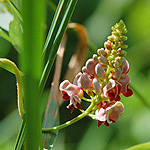
Common Name
Groundnut (Wild Bean, Indian Potato)
Scientific Name
Apios americana Medik.
Plant Family
Pea (Fabaceae)
Garden Location
Woodland and Upland
Prime Season
Late Summer to Early Autumn Flowering
Groundnut is a native perennial twining vine that can grow up to seven feet in length, no tendrils.
Leaves: The leaf has five or more slightly stalked leaflets, always an odd number. Leaflets have smooth margins, are ovate to lanceolate in shape, may have fine hair on the underside and the terminal leaflet is larger and on a longer stalk. There are linear stipules at the base of the leaf.
The inflorescence is a short dense conical raceme that appears among the leaves, growing from the leaf axils. The stalk of the raceme is generally smooth, has a small bract and a gland in the stem axil.
The flowers are pink to deep purple, in a typical pea form and 5-parted. The petals of the flower have the large upper petal (the standard or banner) rounded on the front edges, folded over along a front-to-back axis and colored creamy white to reddish brown. The two side petals (wings or laterals) are curved down and forward and are a brownish purple; the two lower petals (the keel) are sickle shaped and brownish red. Unusually, the top of the keel curves and rises between the two side petals to just under the standard. Like most pea family flowers, the reproductive parts are enclosed by the keel petals. These parts are 10 stamens with yellow anthers, ovary and a style - all curved inside the keel petals. The filaments of the stamens are white and united in a tube. Each flower is on a short hairless stalk.
Fruit: The plant produces edible tubers which grow from slender rhizomes. They look like rounded small potatoes. (see "Uses" below). The above ground fruit is a bean type pod containing several seeds.
Habitat: Groundnut grows in moist to mesic soils in meadows, woodland edges and stream banks. The root system is rhizomatous some of which enlarge and produce the tubers. Groundnut can reproduce by either the pod seeds or the underground tubers. The plant has a history of human use. It can also be used as an ornamental, but can become invasive.
Names: The genus Apios is Greek for pear, referring to the tuber shape. The species americana refers to this species being of the New World. The author name for the plant classification (1787) - ‘Medik’ is for Friedrich Kasimir Medikus (1738-1808) German botanist, director of the University of Heidelberg and curator of the botanical garden at Mannheim. An older name for the species published by Moench in 1795 is Apios tuberosa, but that name is no longer accepted.
Comparisons: There are only two species of this genus in North America and only five in the world. This is the only species of Apios found in Minnesota and the flower cluster will distinguish it from other vines.

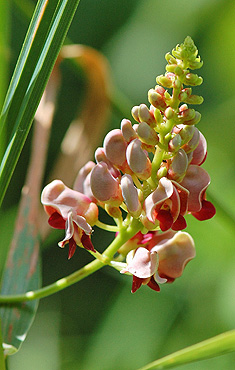
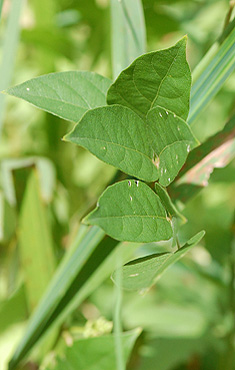
Above: 1st & 2nd photos - Groundnut flowers around mid-August to September depending on the year's weather. The inflorescence is a conical raceme. 3rd photo - Leaves have 5 or more stalked leaflets.
Below: 1st photo - At the base of the stalk of the flower raceme is a small bract and gland. 2nd photo - At the base of each leaf is a pair of small pointed stipules covered with fine hair. 3rd photo - The underside of the leaflet can have many fine hair as does the stalk and the stem of the leaf.
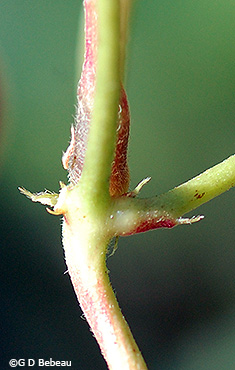


Below: 1st photo - The banner petal is folded along a front to back axis and is colored from creamy to reddish brown. In the forward facing flower you can see the two projecting side petals with the curved keel rising between them. 2nd photo - a leaf with 7 leaflets - always an odd number.
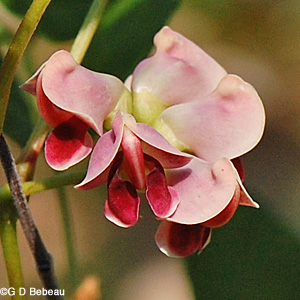

Below: The two keel petals enclose the reproductive parts of the flower. 1st photo - with the lateral petals held back you see how the stamens and style curve inside the keel petals. 2nd photo - with the keel removed the connected filaments of the stamens are visible.
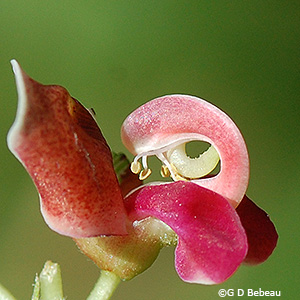
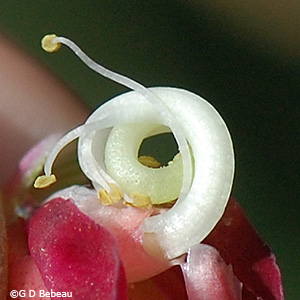
Notes: Groundnut is indigenous to the Garden area. Eloise Butler catalogued it on Sept. 6, 1907 using the older name of Apios tuberosa. Martha Crone planted it in 1946 and '49. Groundnut is native to a number of scattered counties in Minnesota, mostly in the eastern half of the state. It is found in North America from the east coast westward into the Great Plains.
Uses: The plant has a history of human use. It can also be used as an ornamental, but can become invasive. Groundnuts are a good source of carbohydrates and contain between 13 and 17 percent protein by dry weight - about three times as much as potatoes. Groundnut was used a food source by many Native American groups in the eastern parts of the country and west to the wet parts of the prairies where there is a record of its use by the Omaha, Dakota, Santee Sioux, Cheyenne, Osage, Pawnee and Hidatsa. It was also an important food source for the New England Colonists once they discovered it. Captain John Smith wrote about them in his Virginia. Tubers are best when gathered in the late fall and winter, however it takes two to three years for them to reach harvesting size.
Roasted or boiled - two differing opinions: Edwin Way Teale in his book A Walk Through the Year, writes they are best roasted, as boiling them releases a fluid that becomes glue-like when heated by boiling. This residue coats your teeth and the inside of pots, requiring a strong cleaner and cleaning pad to remove. Henry Thoreau, in his journal, preferred them boiled - perhaps he liked the glue.
Cultivation as a crop has been unsuccessful as the tubers lie close to the ground surface making cultivation difficult, plus it takes three years for a good crop. Not fast enough for today's growers. Fernald has many details on historical use (Ref. #6). It has also been noted that about 5% of the people who eat Groundnut will have a reaction to it on the second or third and every subsequent eating. Here is a modern article about the food use of Groundnut (PDF).
Return to -- Site Plan/Archive Index --or-- List of Common Plant Names -- or -- List of Scientific Names -- or --Home Page - - - Back to top.
References: Plant characteristics are generally from sources 1A, 32, W2, W3, W7 & W8 plus others as specifically applied. Distribution principally from W1, W2 and 28C. Planting history generally from 1, 4 & 4a. Other sources by specific reference. See Reference List for details.
 Identification booklet for most of the flowering forbs and small flowering shrubs of the Eloise Butler Wildflower Garden. Details Here.
Identification booklet for most of the flowering forbs and small flowering shrubs of the Eloise Butler Wildflower Garden. Details Here.
©2013
Friends of the Wildflower Garden, Inc. Text and photos are by G. D. Bebeau unless otherwise credited. "www.friendsofeloisebutler.org"
041920